Abstract
A 48-yr-old Caucasian female of central European origin (subject IM) with low plasma cholesterol and normal plasma triglyceride (TG) had extremely low apo A-I (6 mg/dl), A-II (5 mg/dl), and HDL cholesterol (2 mg/dl) levels. She had most of the clinical symptoms typically associated with Tangier disease, including early corneal opacities, yellow-streaked tonsils, hepatomegaly, and variable degrees of peripheral neuropathy, but had no splenomegaly. She had a myocardial infarction at age 46. Since HDL are postulated to be involved in the transport of excess cholesterol from peripheral tissues to the liver for degradation, and the ability of an HDL particle to promote cellular cholesterol efflux appears to be related to its density, size, and apo A-I and A-II contents, we isolated and characterized the HDL particles of this patient and all her first degree relatives (mother, a brother, and two children). The plasma A-I, A-II, and HDL cholesterol levels of all five relatives were either normal or high. Using anti-A-I and anti-A-II immunosorbents, we found three populations of particles in IM: one contained both apo A-I and A-II, Lp(AI w AII); one contained apo A-I but no A-II, Lp(AI w/o AII); and the third (an unusual one) contained apo A-II but no A-I, Lp(AII). Two-thirds of her plasma A-I and A-II existed in separate HDL particles, i.e., in Lp(AI w/o AII) and Lp(AII), respectively. Only Lp(AI w AII) and Lp(AI w/o AII) were present in the plasma of the relatives. All three populations of the patient's HDL particles had a normal core/surface lipid ratio, but the cores were enriched with TG. The apo A-I-containing particles, however, were considerably smaller and contained much less lipid than Lp(AII). Despite these unusual physicochemical characteristics, the apo A-I-containing particles and Lp(AII) were effective suppressors of intracellular cholesterol esterification in cholesterol-loaded human skin fibroblast. The patient's plasma apo D and lecithin cholesterol acyltransferase levels were reduced, with an increased proportion located in non-HDL plasma fractions. These findings are discussed in light of Tangier disease and other known HDL-deficiency cases, and the role of HDL in the maintenance of cell cholesterol homeostasis.
Full text
PDF
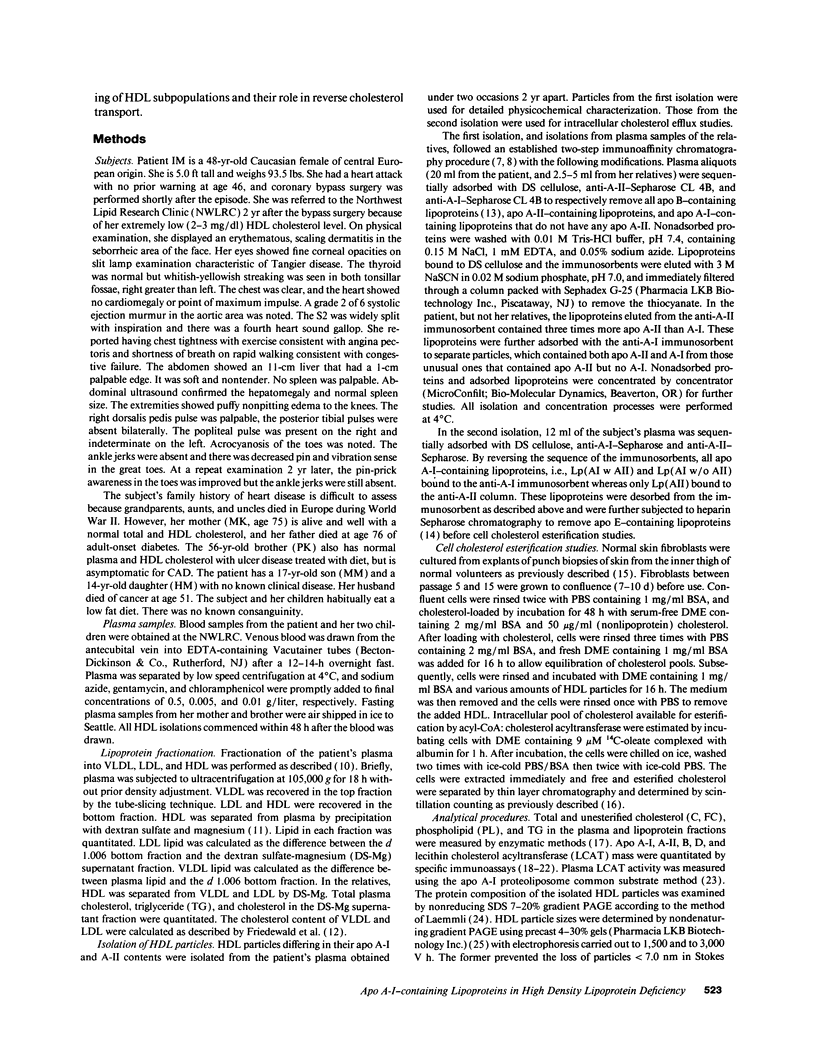
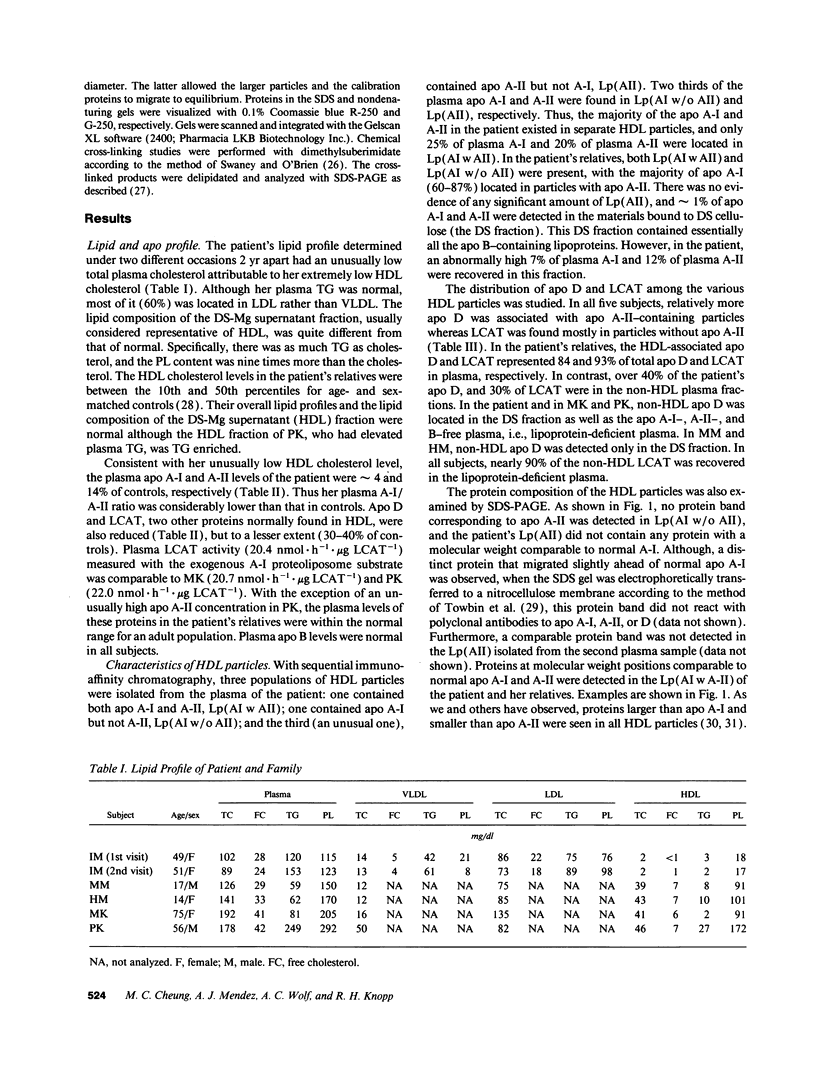

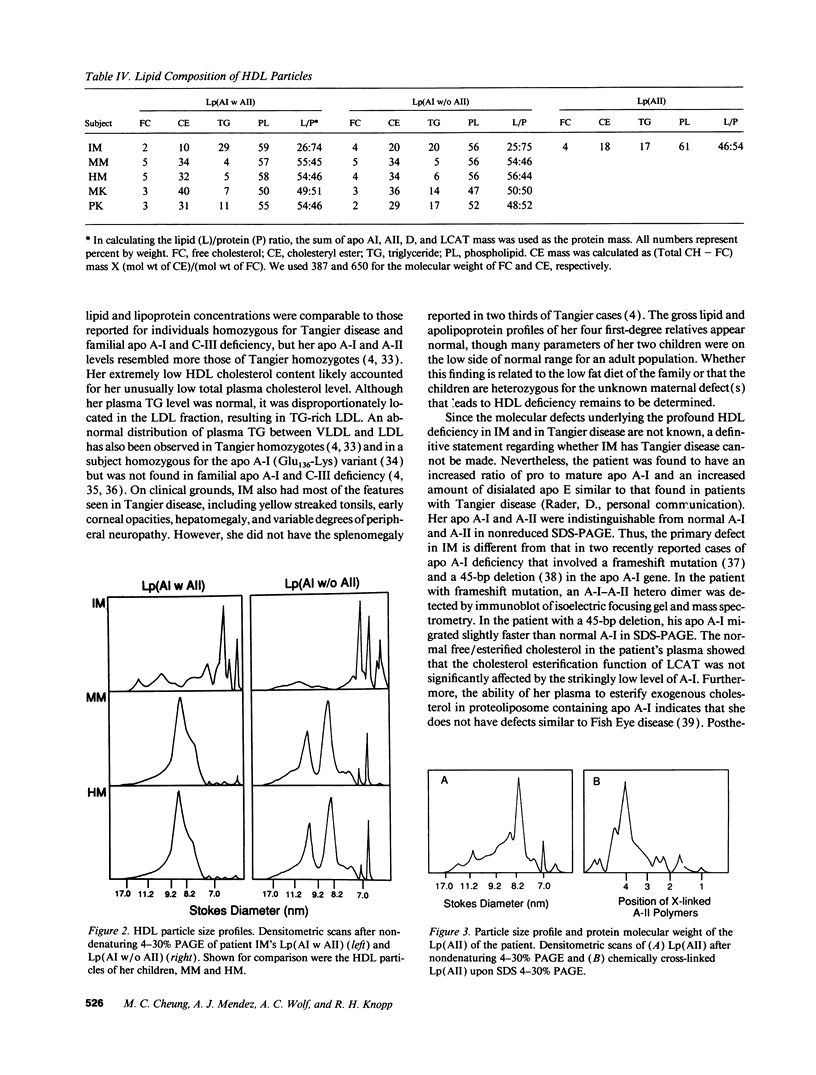
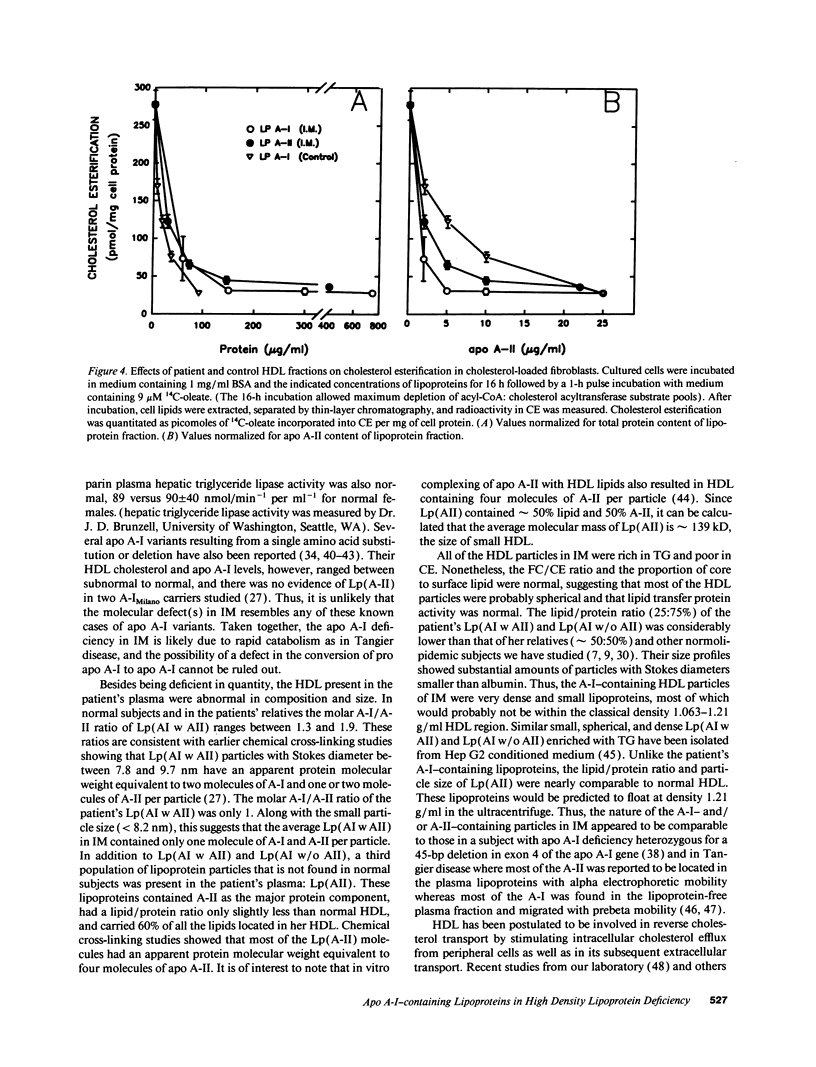
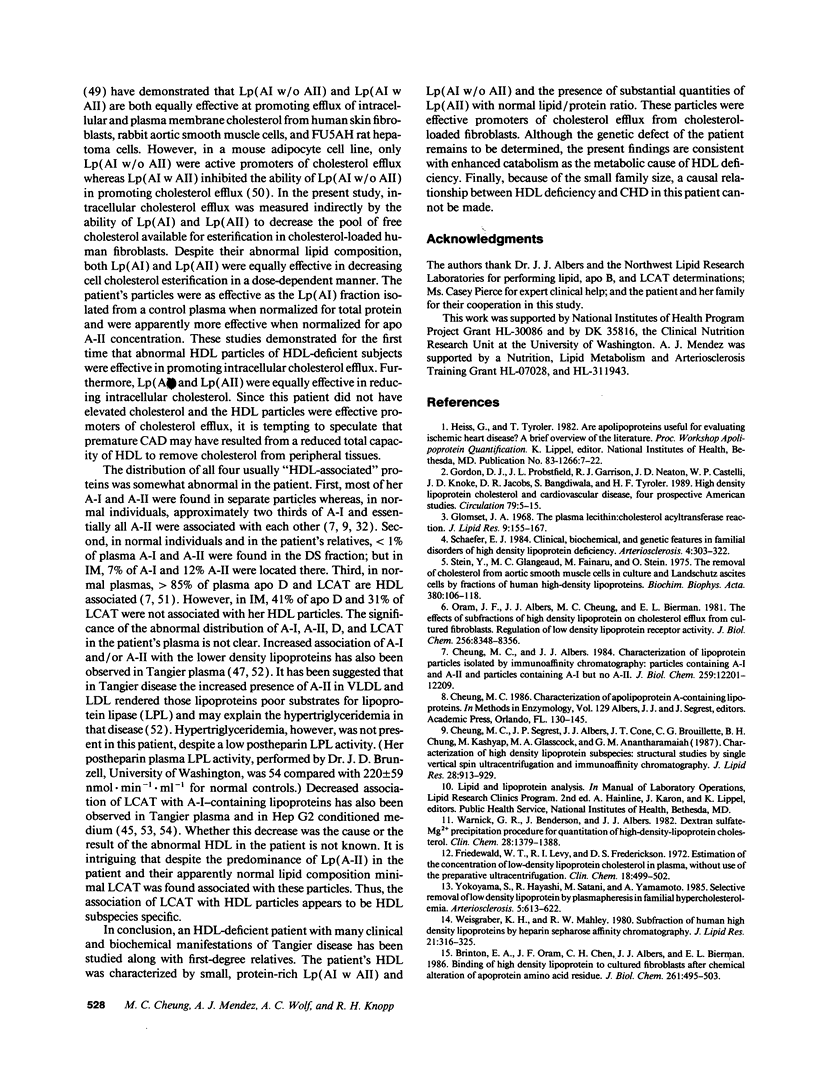
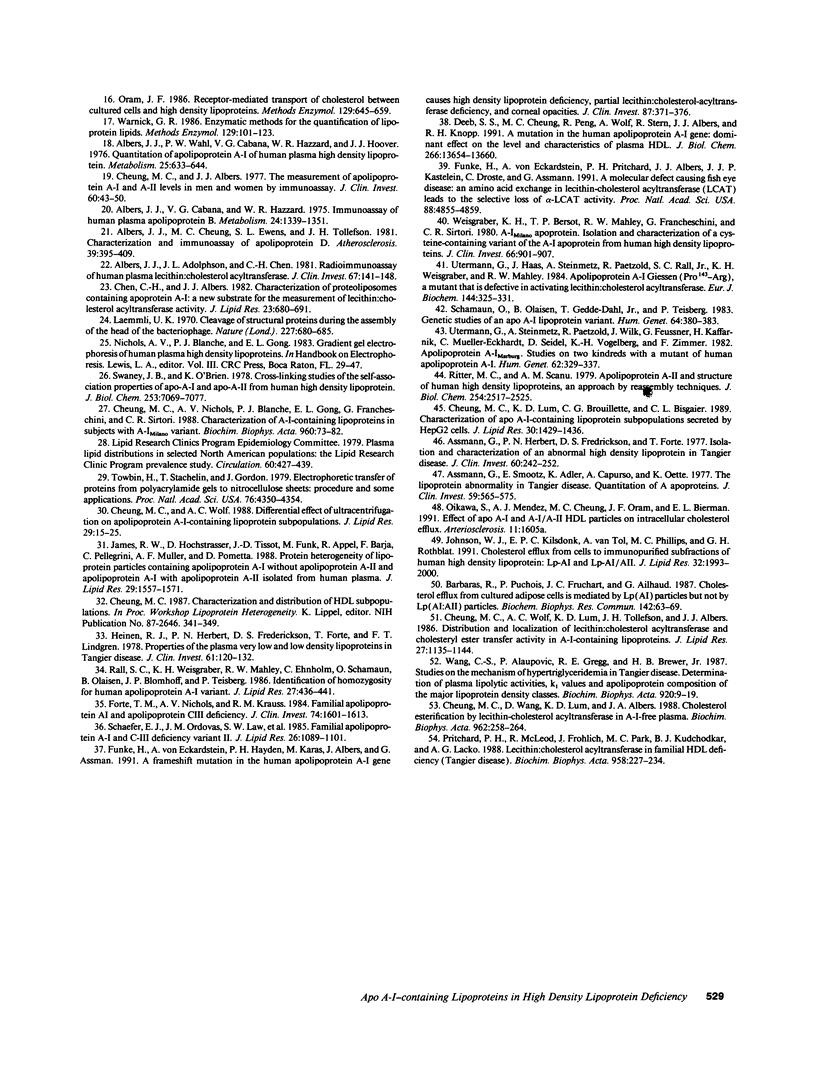
Images in this article
Selected References
These references are in PubMed. This may not be the complete list of references from this article.
- Albers J. J., Adolphson J. L., Chen C. H. Radioimmunoassay of human plasma lecithin-cholesterol acyltransferase. J Clin Invest. 1981 Jan;67(1):141–148. doi: 10.1172/JCI110006. [DOI] [PMC free article] [PubMed] [Google Scholar]
- Albers J. J., Cabana V. G., Hazzard W. R. Immunoassay of human plasma apolipoprotein B. Metabolism. 1975 Dec;24(12):1339–1351. doi: 10.1016/0026-0495(75)90050-5. [DOI] [PubMed] [Google Scholar]
- Albers J. J., Cheung M. C., Ewens S. L., Tollefson J. H. Characterization and immunoassay of apolipoprotein D. Atherosclerosis. 1981 Jun;39(3):395–409. doi: 10.1016/0021-9150(81)90025-3. [DOI] [PubMed] [Google Scholar]
- Albers J. J., Wahl P. W., Cabana V. G., Hazzard W. R., Hoover J. J. Quantitation of apolipoprotein A-I of human plasma high density lipoprotein. Metabolism. 1976 Jun;25(6):633–644. doi: 10.1016/0026-0495(76)90060-3. [DOI] [PubMed] [Google Scholar]
- Assmann G., Herbert P. N., Fredrickson D. S., Forte T. Isolation and characterization of an abnormal high density lipoprotein in Tangier Diesase. J Clin Invest. 1977 Jul;60(1):242–252. doi: 10.1172/JCI108761. [DOI] [PMC free article] [PubMed] [Google Scholar]
- Assmann G., Smootz E., Adler K., Capurso A., Oette K. The lipoprotein abnormality in Tangier disease: quantitation of A apoproteins. J Clin Invest. 1977 Mar;59(3):565–575. doi: 10.1172/JCI108672. [DOI] [PMC free article] [PubMed] [Google Scholar]
- Barbaras R., Puchois P., Fruchart J. C., Ailhaud G. Cholesterol efflux from cultured adipose cells is mediated by LpAI particles but not by LpAI:AII particles. Biochem Biophys Res Commun. 1987 Jan 15;142(1):63–69. doi: 10.1016/0006-291x(87)90451-7. [DOI] [PubMed] [Google Scholar]
- Brinton E. A., Oram J. F., Chen C. H., Albers J. J., Bierman E. L. Binding of high density lipoprotein to cultured fibroblasts after chemical alteration of apoprotein amino acid residues. J Biol Chem. 1986 Jan 5;261(1):495–503. [PubMed] [Google Scholar]
- Chen C. H., Albers J. J. Characterization of proteoliposomes containing apoprotein A-I: a new substrate for the measurement of lecithin: cholesterol acyltransferase activity. J Lipid Res. 1982 Jul;23(5):680–691. [PubMed] [Google Scholar]
- Cheung M. C., Albers J. J. Characterization of lipoprotein particles isolated by immunoaffinity chromatography. Particles containing A-I and A-II and particles containing A-I but no A-II. J Biol Chem. 1984 Oct 10;259(19):12201–12209. [PubMed] [Google Scholar]
- Cheung M. C., Albers J. J. The measurement of apolipoprotein A-I and A-II levels in men and women by immunoassay. J Clin Invest. 1977 Jul;60(1):43–50. doi: 10.1172/JCI108767. [DOI] [PMC free article] [PubMed] [Google Scholar]
- Cheung M. C. Characterization of apolipoprotein A-containing lipoproteins. Methods Enzymol. 1986;129:130–145. doi: 10.1016/0076-6879(86)29066-7. [DOI] [PubMed] [Google Scholar]
- Cheung M. C., Lum K. D., Brouillette C. G., Bisgaier C. L. Characterization of apoA-I-containing lipoprotein subpopulations secreted by HepG2 cells. J Lipid Res. 1989 Sep;30(9):1429–1436. [PubMed] [Google Scholar]
- Cheung M. C., Nichols A. V., Blanche P. J., Gong E. L., Franceschini G., Sirtori C. R. Characterization of A-I-containing lipoproteins in subjects with A-I Milano variant. Biochim Biophys Acta. 1988 May 2;960(1):73–82. doi: 10.1016/0005-2760(88)90011-2. [DOI] [PubMed] [Google Scholar]
- Cheung M. C., Segrest J. P., Albers J. J., Cone J. T., Brouillette C. G., Chung B. H., Kashyap M., Glasscock M. A., Anantharamaiah G. M. Characterization of high density lipoprotein subspecies: structural studies by single vertical spin ultracentrifugation and immunoaffinity chromatography. J Lipid Res. 1987 Aug;28(8):913–929. [PubMed] [Google Scholar]
- Cheung M. C., Wang D. B., Lum K. D., Albers J. J. Cholesterol esterification by lecithin-cholesterol acyltransferase in A-I-free plasma. Biochim Biophys Acta. 1988 Sep 23;962(2):258–264. doi: 10.1016/0005-2760(88)90168-3. [DOI] [PubMed] [Google Scholar]
- Cheung M. C., Wolf A. C. Differential effect of ultracentrifugation on apolipoprotein A-I-containing lipoprotein subpopulations. J Lipid Res. 1988 Jan;29(1):15–25. [PubMed] [Google Scholar]
- Cheung M. C., Wolf A. C., Lum K. D., Tollefson J. H., Albers J. J. Distribution and localization of lecithin:cholesterol acyltransferase and cholesteryl ester transfer activity in A-I-containing lipoproteins. J Lipid Res. 1986 Nov;27(11):1135–1144. [PubMed] [Google Scholar]
- Deeb S. S., Cheung M. C., Peng R. L., Wolf A. C., Stern R., Albers J. J., Knopp R. H. A mutation in the human apolipoprotein A-I gene. Dominant effect on the level and characteristics of plasma high density lipoproteins. J Biol Chem. 1991 Jul 25;266(21):13654–13660. [PubMed] [Google Scholar]
- Forte T. M., Nichols A. V., Krauss R. M., Norum R. A. Familial apolipoprotein AI and apolipoprotein CIII deficiency. Subclass distribution, composition, and morphology of lipoproteins in a disorder associated with premature atherosclerosis. J Clin Invest. 1984 Nov;74(5):1601–1613. doi: 10.1172/JCI111576. [DOI] [PMC free article] [PubMed] [Google Scholar]
- Friedewald W. T., Levy R. I., Fredrickson D. S. Estimation of the concentration of low-density lipoprotein cholesterol in plasma, without use of the preparative ultracentrifuge. Clin Chem. 1972 Jun;18(6):499–502. [PubMed] [Google Scholar]
- Funke H., von Eckardstein A., Pritchard P. H., Albers J. J., Kastelein J. J., Droste C., Assmann G. A molecular defect causing fish eye disease: an amino acid exchange in lecithin-cholesterol acyltransferase (LCAT) leads to the selective loss of alpha-LCAT activity. Proc Natl Acad Sci U S A. 1991 Jun 1;88(11):4855–4859. doi: 10.1073/pnas.88.11.4855. [DOI] [PMC free article] [PubMed] [Google Scholar]
- Funke H., von Eckardstein A., Pritchard P. H., Karas M., Albers J. J., Assmann G. A frameshift mutation in the human apolipoprotein A-I gene causes high density lipoprotein deficiency, partial lecithin: cholesterol-acyltransferase deficiency, and corneal opacities. J Clin Invest. 1991 Jan;87(1):371–376. doi: 10.1172/JCI114997. [DOI] [PMC free article] [PubMed] [Google Scholar]
- Glomset J. A. The plasma lecithins:cholesterol acyltransferase reaction. J Lipid Res. 1968 Mar;9(2):155–167. [PubMed] [Google Scholar]
- Gordon D. J., Probstfield J. L., Garrison R. J., Neaton J. D., Castelli W. P., Knoke J. D., Jacobs D. R., Jr, Bangdiwala S., Tyroler H. A. High-density lipoprotein cholesterol and cardiovascular disease. Four prospective American studies. Circulation. 1989 Jan;79(1):8–15. doi: 10.1161/01.cir.79.1.8. [DOI] [PubMed] [Google Scholar]
- Heinen R. J., Herbert P. N., Fredrickson D. S. Properties of the plasma very low and low density lipoproteins in Tangier disease. J Clin Invest. 1978 Jan;61(1):120–132. doi: 10.1172/JCI108910. [DOI] [PMC free article] [PubMed] [Google Scholar]
- James R. W., Hochstrasser D., Tissot J. D., Funk M., Appel R., Barja F., Pellegrini C., Muller A. F., Pometta D. Protein heterogeneity of lipoprotein particles containing apolipoprotein A-I without apolipoprotein A-II and apolipoprotein A-I with apolipoprotein A-II isolated from human plasma. J Lipid Res. 1988 Dec;29(12):1557–1571. [PubMed] [Google Scholar]
- Johnson W. J., Kilsdonk E. P., van Tol A., Phillips M. C., Rothblat G. H. Cholesterol efflux from cells to immunopurified subfractions of human high density lipoprotein: LP-AI and LP-AI/AII. J Lipid Res. 1991 Dec;32(12):1993–2000. [PubMed] [Google Scholar]
- Laemmli U. K. Cleavage of structural proteins during the assembly of the head of bacteriophage T4. Nature. 1970 Aug 15;227(5259):680–685. doi: 10.1038/227680a0. [DOI] [PubMed] [Google Scholar]
- Oram J. F., Albers J. J., Cheung M. C., Bierman E. L. The effects of subfractions of high density lipoprotein on cholesterol efflux from cultured fibroblasts. Regulation of low density lipoprotein receptor activity. J Biol Chem. 1981 Aug 25;256(16):8348–8356. [PubMed] [Google Scholar]
- Oram J. F. Receptor-mediated transport of cholesterol between cultured cells and high-density lipoproteins. Methods Enzymol. 1986;129:645–659. doi: 10.1016/0076-6879(86)29096-5. [DOI] [PubMed] [Google Scholar]
- Pritchard P. H., McLeod R., Frohlich J., Park M. C., Kudchodkar B. J., Lacko A. G. Lecithin:cholesterol acyltransferase in familial HDL deficiency (Tangier disease). Biochim Biophys Acta. 1988 Feb 4;958(2):227–234. doi: 10.1016/0005-2760(88)90181-6. [DOI] [PubMed] [Google Scholar]
- Rall S. C., Jr, Weisgraber K. H., Mahley R. W., Ehnholm C., Schamaun O., Olaisen B., Blomhoff J. P., Teisberg P. Identification of homozygosity for a human apolipoprotein A-I variant. J Lipid Res. 1986 Apr;27(4):436–441. [PubMed] [Google Scholar]
- Ritter M. C., Scanu A. M. Apolipoprotein A-II and structure of human serum high density lipoproteins. An approach by reassembly techniques. J Biol Chem. 1979 Apr 10;254(7):2517–2525. [PubMed] [Google Scholar]
- Schaefer E. J. Clinical, biochemical, and genetic features in familial disorders of high density lipoprotein deficiency. Arteriosclerosis. 1984 Jul-Aug;4(4):303–322. doi: 10.1161/01.atv.4.4.303. [DOI] [PubMed] [Google Scholar]
- Schaefer E. J., Ordovas J. M., Law S. W., Ghiselli G., Kashyap M. L., Srivastava L. S., Heaton W. H., Albers J. J., Connor W. E., Lindgren F. T. Familial apolipoprotein A-I and C-III deficiency, variant II. J Lipid Res. 1985 Sep;26(9):1089–1101. [PubMed] [Google Scholar]
- Schamaun O., Olaisen B., Gedde-Dahl T., Jr, Teisberg P. Genetic studies of an apoA-I lipoprotein variant. Hum Genet. 1983;64(4):380–383. doi: 10.1007/BF00292371. [DOI] [PubMed] [Google Scholar]
- Stein Y., Glangeaud M. C., Fainaru M., Stein O. The removal of cholesterol from aortic smooth muscle cells in culture and Landschutz ascites cells by fractions of human high-density apolipoprotein. Biochim Biophys Acta. 1975 Jan 24;380(1):106–118. doi: 10.1016/0005-2760(75)90049-1. [DOI] [PubMed] [Google Scholar]
- Swaney J. B., O'Brien K. Cross-linking studies of the self-association properties of apo-A-I and apo-A-II from human high density lipoprotein. J Biol Chem. 1978 Oct 10;253(19):7069–7077. [PubMed] [Google Scholar]
- Towbin H., Staehelin T., Gordon J. Electrophoretic transfer of proteins from polyacrylamide gels to nitrocellulose sheets: procedure and some applications. Proc Natl Acad Sci U S A. 1979 Sep;76(9):4350–4354. doi: 10.1073/pnas.76.9.4350. [DOI] [PMC free article] [PubMed] [Google Scholar]
- Utermann G., Haas J., Steinmetz A., Paetzold R., Rall S. C., Jr, Weisgraber K. H., Mahley R. W. Apolipoprotein A-IGiessen (Pro143----Arg). A mutant that is defective in activating lecithin:cholesterol acyltransferase. Eur J Biochem. 1984 Oct 15;144(2):325–331. doi: 10.1111/j.1432-1033.1984.tb08467.x. [DOI] [PubMed] [Google Scholar]
- Utermann G., Steinmetz A., Paetzold R., Wilk J., Feussner G., Kaffarnik H., Mueller-Eckhardt C., Seidel D., Vogelberg K. H., Zimmer F. Apolipoprotein AIMarburg: studies on two kindreds with a mutant of human apolipoprotein AI. Hum Genet. 1982;61(4):329–337. doi: 10.1007/BF00276597. [DOI] [PubMed] [Google Scholar]
- Wang C. S., Alaupovic P., Gregg R. E., Brewer H. B., Jr Studies on the mechanism of hypertriglyceridemia in Tangier disease. Determination of plasma lipolytic activities, k1 values and apolipoprotein composition of the major lipoprotein density classes. Biochim Biophys Acta. 1987 Jul 13;920(1):9–19. doi: 10.1016/0005-2760(87)90305-5. [DOI] [PubMed] [Google Scholar]
- Warnick G. R., Benderson J., Albers J. J. Dextran sulfate-Mg2+ precipitation procedure for quantitation of high-density-lipoprotein cholesterol. Clin Chem. 1982 Jun;28(6):1379–1388. [PubMed] [Google Scholar]
- Warnick G. R. Enzymatic methods for quantification of lipoprotein lipids. Methods Enzymol. 1986;129:101–123. doi: 10.1016/0076-6879(86)29064-3. [DOI] [PubMed] [Google Scholar]
- Weisgraber K. H., Bersot T. P., Mahley R. W., Franceschini G., Sirtori C. R. A-Imilano apoprotein. Isolation and characterization of a cysteine-containing variant of the A-I apoprotein from human high density lipoproteins. J Clin Invest. 1980 Nov;66(5):901–907. doi: 10.1172/JCI109957. [DOI] [PMC free article] [PubMed] [Google Scholar]
- Weisgraber K. H., Mahley R. W. Subfractionation of human high density lipoproteins by heparin-Sepharose affinity chromatography. J Lipid Res. 1980 Mar;21(3):316–325. [PubMed] [Google Scholar]
- Yokoyama S., Hayashi R., Satani M., Yamamoto A. Selective removal of low density lipoprotein by plasmapheresis in familial hypercholesterolemia. Arteriosclerosis. 1985 Nov-Dec;5(6):613–622. doi: 10.1161/01.atv.5.6.613. [DOI] [PubMed] [Google Scholar]



